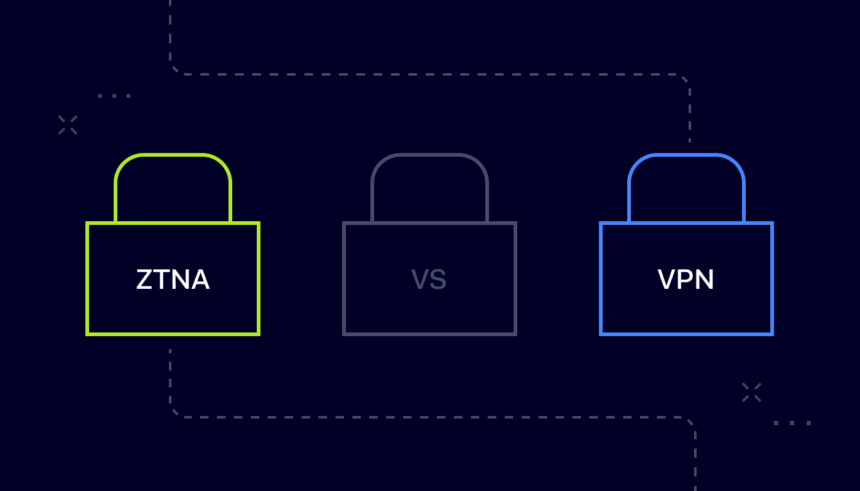Introduction to Secure Networking
Getting secret information and organization frameworks is a specialized and key business basic in the consistently developing computerized age. Organizations and people are persistently looking for answers for safeguard their advanced correspondences in light of heightening digital dangers and protection concerns. Whether or not to execute Zero Trust Network Access (ZTNA) or stay with the conventional Virtual Private Network (VPN)is turning out to be progressively huge. Those gauging the general benefits of ZTNA versus VPN should comprehend the intricacies and subtleties associated with every choice to make educated, vital choices.
ZTNA, with its establishment in the Zero Trust Security model, involves rigid personality confirmation and access control — it is safely validated and approved to guarantee each organization’s exchange. Then again, VPN innovation has generally been utilized to broaden the border of a solid organization to far off clients. This initial dichotomy between ZTNA and VPN’s security protocols and principles offers a backdrop for a detailed discussion about their effectiveness in protecting digital assets in the modern technological landscape.
Understanding Zero Trust Network Access (ZTNA)
Comparing ZTNA versus VPN underscores the distinct paradigms in network security. The Zero Trust model embodies a cautious yet practical approach, recognizing trust as a potential vulnerability adversaries exploit. ZTNA adheres rigorously to the principle of never defaulting to trust, whether within or beyond the network perimeter. In practice, ZTNA solutions meticulously verify each user’s identity through robust authentication methods and strictly limit their access to network resources, granting only what’s necessary and nothing more. This departure from traditional trust models towards perpetual skepticism has gained traction across various industries and sectors.
At the core of ZTNA’s effectiveness lies its meticulous identity verification process, complemented by dynamic security policies that adapt to real-time user actions’ risk levels. Comparatively, VPNs traditionally create a secure connection between remote users and a private network, often granting broader access privileges. While VPNs have been a longstanding solution for secure remote access, ZTNA’s granular control and continuous verification offer heightened security in an increasingly threat-prone landscape.
This elegant, context-aware framework ensures that compliance is maintained and sensitive data remains insulated from unauthorized access. As technology advances, ZTNA’s mechanisms are refined and essential to a holistic cybersecurity strategy.
The Coustomary Job of Virtual Private Networks (VPN)
The heritage of VPNs is deeply rooted in creating secure, encrypted tunnels between remote users and a central network, thereby enabling data transmission over unsecured networks like the Internet with enhanced privacy and safety. VPNs have provided a lifeline for businesses and remote users for many years to maintain productivity without compromising network integrity. Despite the simplicity and broad applicability of VPNs, which have made them a staple in many corporate environments, their trust-based model and potential over-reliance on perimeter security have prompted a reconsideration of their role in the face of new cyber threats.
VPNs excel in scenarios where secure, compliant, remote access is required. However, as the network perimeter dissolves with the rise in cloud services and BYOD (Bring Your Device) policies, VPNs need help to keep up with the dynamic access needs and the high level of threats that can perforate a network’s bounds. Their limitations have led security experts to seek alternative security solutions offering a more granular and context-responsive approach to access management.
ZTNA Versus VPN: A Relative Examination:
When `ZTNA versus VPN` are positioned side by side for evaluation, distinct differences in their security philosophies and operational efficiencies come into stark relief. ZTNA is tailored for today’s cloud-centric environments, offering a precise and flexible approach to resource access using micro-segmentation and dynamic policy application. Its agility in adjusting access privileges based on continuous trust assessments efficiently shores security postures in the modern web of devices and services.
VPNs, characterized by their broad network access strategy, may need help matching the specificity and responsiveness level inherent in ZTNA frameworks. Nonetheless, the well-established nature of VPN technology means that it still holds value and offers a familiar and proven solution for specific network configurations. This is particularly true in scenarios that demand comprehensive network access for users in a secure and controlled fashion.
The Impact of Remote Work on Security Needs
The seismic shift towards remote work has irrevocably altered the corporate network landscape, introducing new complexities and reinforcing the need for fortified security models. The traditional network perimeter has virtually vanished as employees tap into network resources from many locations and devices. This workforce dispersion underscores the necessity for a security approach that does not rely on physical location or inherent trust. The emphasis on securing resources regardless of where the access request originates is a central tenet of the Zero Trust model, making ZTNA particularly advantageous in remote work. According to insights by Cybersecurity Dive, businesses increasingly recognize the need for a more nuanced and modern security framework that ZTNA promises, especially given the surge in remote work propelled by global events.
Advantages of ZTNA in Protecting Modern Networks
The approach to network security is undergoing a renaissance with ZTNA at the vanguard. Offering a multitude of advantages, ZTNA prioritizes security through meticulously crafted access policies and tech-savvy micro-segmentation, partitioning the network into distinct zones where user access is stringently controlled. This minimizes the likelihood of unauthorized intrusions and limits the reach of any potential breach within the network, effectively containing threats and minimizing their impact. Moreover, organizations with ZTNA can adapt and scale their security measures as their business grows or transforms, maintaining the current operational efficiency and future-proofing measures.
Aiding compliance with industry regulations and legislation is another formidable benefit of ZTNA. Enhancing confidence and responsibility towards data security, its transparent and granular system effortlessly conforms to data protection standards, including GDPR, HIPAA, and other regional data protection legislation.
Limitations and Considerations When Implementing ZTNA
Even with the compelling advantages of ZTNA, transitioning to this framework does entail its set of challenges. Starter companies with intricate legacy IT infrastructures may need help to pivot to the Zero Trust model, as these environments are traditionally built on and operate under implicit trust principles. This transition may demand significant investment in technology and training—the need for IT staff to become proficient with cutting-edge identity verification techniques and policy management systems forms a steep learning curve that cannot be ignored.
Businesses must weigh these challenges against the undeniable security enhancements provided by ZTNA. To guarantee they are prepared for this groundbreaking reception, partners should completely evaluate their ongoing foundation, processes, and, in particular, their corporate culture.
The Job of VPNs in The present Security Biological system
Concerning as outdated in the ongoing security ecosystem is nearsighted. A VPN has its merits, notably in hybrid environments where specific applications or services demand a traditional network structure or where users require comprehensive network access under secured conditions. It remains an effective solution in particular user-base segments, prioritizing accessibility and simplicity. Even as the focus shifts towards ZTNA, the role of VPNs persists, morphing and evolving with more advanced security methodologies; by complementing VPN technology with additional security measures, businesses can ensure a more secure and flexible access landscape.
Executing a Protected Systems administration Methodology
In an era ever more dependent on digital connectivity, determining the optimal network security strategy is vital. Organizations must navigate the decision-making process with ample knowledge about the strengths and weaknesses of both ZTNA and VPN. They must appraise their individual security needs, operational dynamics, and the nature of the networks in use while encouraging a culture of security awareness. Adequate network security is as much about utilizing the right technologies as it fosters the right mindset among users and administrators.
Conclusion: Towards a More Secure Networking Approach
As we conclude our exploration into ZTNA and VPN, it’s evident that the future of network security will be characterized by intelligent, adaptable solutions that can respond to complex, shifting threat landscapes. By embracing innovations like ZTNA, organizations can cultivate a more secure, flexible network approach tailored to their unique needs. Meanwhile, the role of VPNs, though changing, remains an integral part of the security fabric for specific scenarios. Therefore, The informed decision lies in understanding the available tools and recognizing that adopting a more secure network is an ongoing journey of adaptation and resilience.






